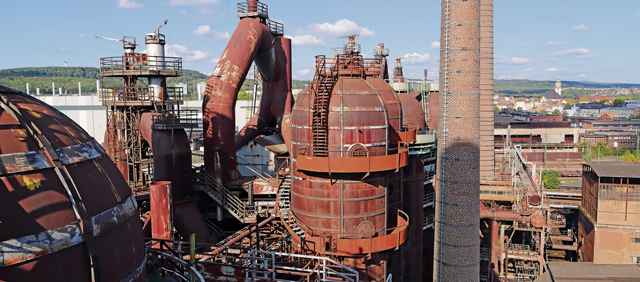
Looking for something to do on a spring weekend and experience an awesome, historic and red-hot steel setting? An exciting option may be just down the road towards France, full of Saarland’s coal and iron history, interesting changing exhibits and a trip into the past.
The Völklingen Ironworks (Germaan: Völklinger Hütte) is a former blast-furnace complex located in the town of Völklingen, just past Saarbrücken. It was declared a UNESCO World Heritage site in 1994 due to its exceptional preservation and testimony to ferrous metallurgy and the Industrial Revolution.
Iron production took place from 1882 until 1986, when it had to be closed due to ecological reasons. Sink holes, attributed to coal mining, were discovered throughout Saarland and the additional steel crisis made this step inevitable. Up until then it was the only intact ironworks surviving the 19th and early 20th centuries in Europe and North America.
In 1873 Julius Buch planned and built steel works on the banks of the Saar River, an ideal location close to numerous coal mines in the region. In 1881 Karl Röchling acquired the complex and constructed a blast furnace for producing iron and two years later smelter operations began. Furnaces were added between 1885 and 1893 and a coking plant was opened in 1897. In 1900 the first gas-blowing engines were introduced, making it the first large-scale ironworks to use gas to operate the blast furnaces. By 1910, Völklingen Ironworks was Germany’s largest producer of steel beams, a large conveyor belt system was installed in the plant, and the technology used at the ironworks became a model for other factories across the world during the early 20th century.
With a shortage of labor during and after World War I, up to 1,446 people from territories occupied by Germany, most of them from Russia and Belgium, were forced to work involuntarily at the ironworks between 1915 and 1918. Forced labor was again used in World War II, when a total of 12,393 people, including prisoners of war and civilians deported from the Soviet Union, worked at the plant under miserable conditions. After World War II, only minor maintenance was conducted until the plant closed in 1986, but retains its 1930s-era appearance today, with intact blast furnaces and the original coking plant. In 1996 the museum was opened with the aim of presenting its history and making the site culturally accessible for visitors to explore and dive into the past.
UNESCO World Heritage Site
Today the Völklinger Hütte is a hands-on museum and also a unique location for international exhibitions, festivals and concerts. The Ferrodrom is an interactive science center focusing on the making of iron and visitors can tour the production areas, where huge gas machines stand in the blower hall. The outdoor area features tall towers with a platform at 45 meters (147 feet) height with a grand view over the vast and almost spooky premises. Since 2011 it has also been a venue for the annual UrbanArt Biennale displaying urban art.
In addition to the permanent display on the premises and in production halls, the following exhibitions are currently being featured: German cinema from 1895 to present (until Aug. 2024), “We all except the others” (until Sep. 2024), Movement.Power.History (until Aug. 2024), The Story of Planet A, a comic series of 14 billion years of history (until Apr. 2024), and “Forced Labor,” as a permanent exhibition, and further exhibitions planned later in the year.
The site also offers a bistro with snacks and warm drinks in the historic production hall, and except for the viewing platform, the Völklinger Hütte is easily accessible in all areas via ramps and elevators for walkers, wheelchairs and strollers. Guided tours in German, English, French and sign language are available upon prior request. For details, visit: https://voelklinger-huette.org/en/
Völklinger Hütte will be celebrating its 30th anniversary as World Heritage Site in a large event scheduled for June 2. Also, stay tuned for a Ramstein Road Trip on the topic coming soon!
Why not combine history with a shopping spree and a picturesque stroll along the Saar River, a visit to the grand casino or the prestigious castle with underground tunnels in Saarland’s capital Saarbrücken on the weekend?







